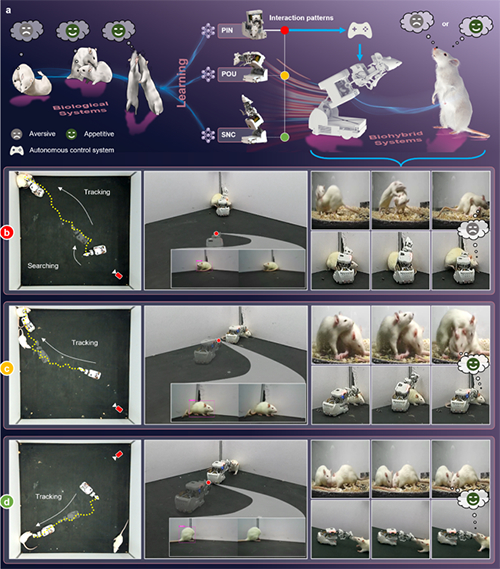

Example of three interaction modes for robot rat: pinching, pouncing, and
social nose contact
Under the support of National Natural Science Foundation projects (approval
numbers: 62022014, 62088101), Professor Shi Qing's team from Beijing Institute
of Technology has made progress in the research of robot animal interaction
through cross collaboration with overseas collaborators. The research findings,
titled "Modulating emotional states of rats through a rat like robot with
learned interaction patterns," were published online on December 5, 2024 in the
journal Nature Machine Intelligence. Paper link:
https://www.nature.com/articles/s42256-024-00939-y .
Robots integrate into biological systems in the form of social agents,
serving as observers and stimuli to interact with animals, helping humans
explore how individuals or groups of animals respond to controlled environmental
changes. This vitality fusion system has controllability and helps to elucidate
potential biological intelligence that cannot be revealed through traditional
methods. However, existing interactive robots still find it difficult to
transmit multiple sensory information in vital fusion systems, and therefore
cannot effectively regulate complex interaction processes. They mainly face
three challenges: 1) integrating multiple sensory perceptions for communication
with animals; 2) To integrate into animal communities, it is necessary to
realistically imitate diverse and complex animal behaviors; 3) How to directly
change the internal state of animals (such as emotions) has not been deeply
explored.
The research team drew inspiration from the anatomical structure, dynamic
movement, and social interaction of rats to develop a miniature mouse like
interactive robot that can mimic various animal social behaviors and
autonomously interact with rats. By establishing a main motion joint mapping
model, a highly flexible multi joint spine structure was designed. Four social
behavior patterns were generated using imitation learning, and an autonomous
control architecture with custom interaction rules was constructed. The proposed
mouse like robot achieved an average of 30 continuous interactions within half
an hour, and was able to attract the attention of rats and significantly
stimulate their interest.
The research results demonstrate that this type of mouse robot has achieved
for the first time the regulation of emotional states in rats (Figure),
overcoming the limitations of natural social interactions within biological
systems. It is expected to help reveal the brain functions and neural circuit
mechanisms behind these decisions or predictions, providing new ideas for
understanding the "social" interactions between humans and artificial
intelligence.